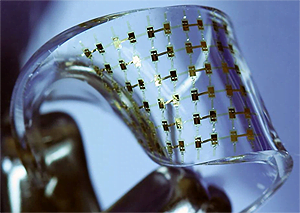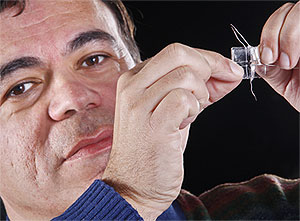CORAL GABLES, Fla., Jan. 22, 2009 – A new design for stretchable electronics that could be used to improve eye cameras, smart surgical gloves, body parts, airplane wings, back planes for liquid crystal displays and biomedical devices has been unveiled.
Jizhou Song, a professor in the University of Miami’s College of Engineering and his collaborators John Rogers, professor at the University of Illinois and Yonggang Huang, professor at Northwestern University have developed the new design that can be wrapped around complex shapes, without a reduction in electronic function.
An optical image of a freely deformed stretchable array of complementary metal-oxide semiconductors inverters. Photo courtesy of John A. Rogers and the University of Illinois at Urbana-Champaign.
The new mechanical design strategy is based on semiconductor nanomaterials that can offer high stretchability and large twistability such as corkscrew twists with tight pitch.
"Our design is of great interest because the requirements for complex shapes that can function during stretching, compression, bending, twisting and other types of extreme mechanical deformation are impossible to satisfy with conventional technology," said Song.
The secret of the design is in the silicon (Si) islands on which the active devices or circuits are fabricated. The islands form a chemically bonded, pre-strained elastomeric substrate. Releasing the pre-strain causes the metal interconnects of the circuits to buckle and form arc-shaped structures, which accommodate the deformation and make the semiconductor materials much more stretchable, without inducing significant changes in their electrical properties. The design is called noncoplanar mesh design.
In related news, engineers at Purdue and Stanford universities have created stretchable electrodes to study how cardiac muscle cells, neurons and other cells react to mechanical stresses from heart attacks, traumatic brain injuries and other diseases.
These devices are made by injecting a liquid alloy made of indium and gallium into thin microchannels between two sheets of a plastic polymer, said Babak Ziaie, a Purdue associate professor of electrical and computer engineering.
Babak Ziaie, a Purdue associate professor of electrical and computer engineering, demonstrates a new "stretchable" electrode. Photo courtesy of Andrew Hancock, Purdue News Service.
"We designed a simple and cost-effective process for fabricating these stretchable platforms," said Ziaie, who is working with Beth L. Pruitt, an assistant professor of mechanical engineering at Stanford, along with graduate students and other researchers at both universities. "What's special about this technology is that it allows you to electrically stimulate or monitor the cell population using electrodes while you are applying stress to the cells."
Stretching the cell cultures causes mechanical stresses like those exerted on tissues during heart attacks and traumatic brain injuries. The researchers have grown mice cardiac muscle cells on the platform and may grow cell cultures of neurons in future work. Cultures of stem cells also could be tested using the system to determine how mechanical stresses prompt the cells to differentiate into specific types of tissues, Ziaie said.
Purdue researchers designed and fabricated the platform at the Birck Nanotechnology Center in Purdue's Discovery Park. Stanford researchers grew cardiac muscle cell cultures on the device and tested the platform.
For more information, visit: http://www.umiami.edu/ or http://www.purdue.edu/